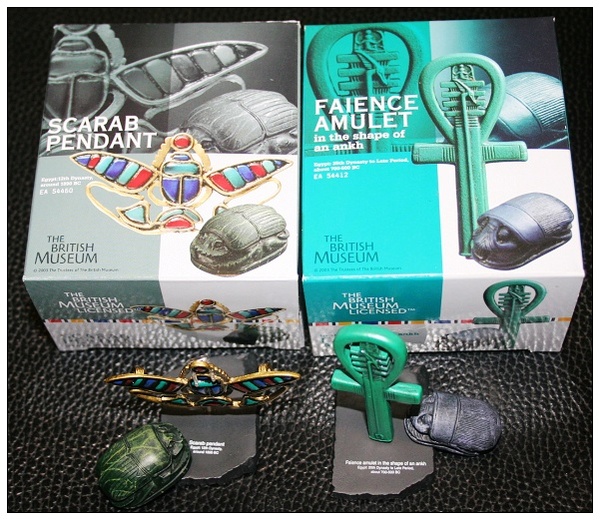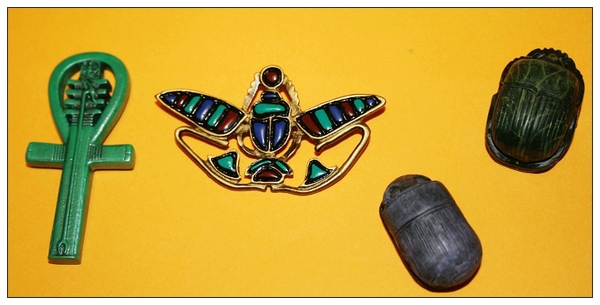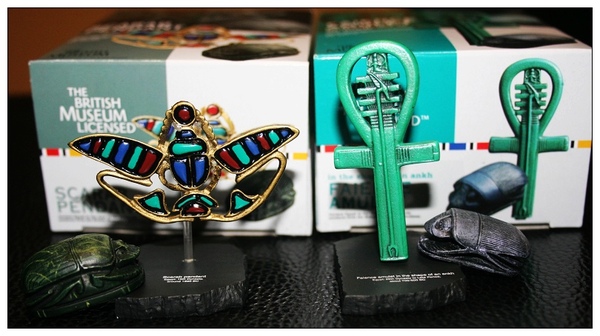
昨天逛了整整一天的故宮,其實就只在大英博物館展區打轉,前後進去三趟,換了一次語音導覽的機器,(因為聽到沒電 )當然少不了要敗點紀念品回家.這就是我買的食玩,小小一丁點兒,卻得用4個小孩來換,真是貴啊.
)當然少不了要敗點紀念品回家.這就是我買的食玩,小小一丁點兒,卻得用4個小孩來換,真是貴啊.
 )當然少不了要敗點紀念品回家.這就是我買的食玩,小小一丁點兒,卻得用4個小孩來換,真是貴啊.
)當然少不了要敗點紀念品回家.這就是我買的食玩,小小一丁點兒,卻得用4個小孩來換,真是貴啊.

這些圖騰符號到底代表啥意義呢?晚點再來補充.

補充:
昨天在現場看這些食玩時,忍不住要碎碎唸:一個賣450,盒子外頭除了"大英博物館250年收藏食玩#7,售價450"的小貼紙外,連個中文說明都沒有!
昨天在現場看這些食玩時,忍不住要碎碎唸:一個賣450,盒子外頭除了"大英博物館250年收藏食玩#7,售價450"的小貼紙外,連個中文說明都沒有!
心中暗忖:該不會裡頭連中文說明書也沒有吧?嗐!果不其然!(倒@@)
先把英文po上,英文強的人,隨便看看就看懂;用firefox瀏覽器的網友也可以把滑鼠移到不認識的字上面,它會自動出現字義.w(←一整個沒誠意表現!!?沒辦法,我看到英文就開始打瞌睡了...)
#7
Scarab Pendant
Egypt :12th Dynasty, around 1890 BC
Height :1.8 cm / Length : 3.5 cm(wing span)
This is a pendant in the form of a winged scarab.It is made of electrum(a naturally occurring alloy of gold and silver) inlaid with carnelian, green feldspar and lapis lazuli.
The central ornament forms the first name of King Senwosret II. The name is composed of the sun disc, scarab and the rising sun sign beneath.Because the beetle lays eggs in a ball of dung and pushes it around, the Egyptians used it as an image and metaphor for the passage of the sun across the sky.
#10
Faience amulet in the shape of an ankh
Egypt : 25th Dynasty to Late Period, about 700-500 BC
Length : 23.5cm
This amulet expresses more than just the value of the ankh hieroglyph(meaning "life"). Combined with the ankh are: The was-sceptre, the hieroglyph for "power", or "dominion"
The djed pillar, the hieroglyph for the "stability" The heh, a man with upraised arms, the hieroglyph for "millions"
The whole object taken together represents a wish of "life", power and stability for millions of years", a very common type of Egyptian royal expression.
護心聖甲蟲是埃及人的護身符,通常也放在木乃伊的胸前,因為心臟是很重要的器官.古埃及人相信,人類是用心臟來思考的,所以,人死後,除了心肝肺腸胃等五臟留著外,其餘內臟包刮腦都會被抽出,肺肝腸胃分別放入4個陶罐(canopic jar)裡保藏,而心臟就留在體內,由聖甲蟲負責保護.(待續)
文章標籤
全站熱搜

